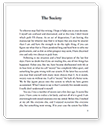Essay Instructions: TREATMENT OF WRITTEN ERROR CORRECTION BY ESOL TEACHERS IN COLLEGE OF LONDON (East London) AT ELEMENTARY, INTERMEDIATE AND ADVANCED LEVEL
My research questions are:(The research question are the things what I want to explore discover and about what my dissertation will be about)
1.What is the effectiveness of certain types of error treatment methods?
2.How actual language teachers deal with L2 learners’ written errors at elementary, intermediate and advanced level in CL?
3.What types of written errors ESOL teachers correct in elementary, intermediate and advanced level in OL?
4.What are the methods different teachers use to correct written errors in the context of College of London (ESOL classes)
5.What is the relationship between the literature and actual practice in terms of error treatment of written work?
6.How student react for different feedback. Which one is the best??
Writing the Dissertation
The unbound portfolio should be presented in the following order: title page, marking criteria, abstract, introduction, literature review, methodology, results, reference list, marked up presentation handout, Turnitin originality report and appendices. Please do not include Acknowledgements or a Table of Contents. See next page for details.
Abstract: 0 to 150 words. The abstract goes on a separate page, is not included in the page numbering of the essay or in the word count. The abstract is a brief discussion of research question, why you chose the topic, how you did your research, who you researched and what you found out. – 10% mark
Introduction: 500 to 1000 words. This should include the context, history, background and terminology appropriate to your research topic and question. This is the place to discuss the general topic and to narrow down the topic to the specific research question(s). 15% mark
1.1 Introduction
1.2 Background to the Research Problem
1.3 Purpose of the Study
1.4 Significance of the Study
1.5 Concluding Remarks
Literature Review: 2500 to 3000 words. This may be organised chronologically or according to theme and must link directly to your research. The purpose of the literature review is to clarify the relationship between published research and your own research. 15% mark.
1 Introduction
2.2 Definition of Terms
2.2.1 Introduction
2.2.2 Definition of error
2.2.3 Definition of error treatment
2.3 Issues of Error Treatment in Second Language Acquisition
2.3.1 Introduction
2.3.2 Overview of research on error treatment: Whether or not?
2.3.2.1 Historical background
2.3.2.2 Negative perspectives of error treatment
2.3.2.3 Positive perspectives of error treatment
2.3.3 Types of learner errors: What to correct?
2.3.3.1 Introduction
2.3.3.2 Pedagogical focus
2.3.3.3 Error frequency
2.3.4 Types of error treatment methods: How to correct?
2.3.4.1 Introduction
2.3.4.2 Explicit vs. implicit correction
2.3.4.3 Degree of explicitness
2.3.4.3.1 Level of TL proficiency
2.3.4.3.2 Purposes of TL learning
2.3.4.3.3 Types of errors
2.3.4.4 Correction codes and TAXONOMIES such as…(see John Gray coursework)
2.4 Concluding Remarks
Methodologies and methods: 1500 to 2500 words. This should include a discussion of possible appropriate methods and their advantages and disadvantages. Make sure that you have proper triangulation and address the reliability, validity and ethics of your methods. Any data collection instruments such as transcripts of interviews, copies of questionnaires etc go in the appendix. 15%mark
3.1 Introduction
3.2 Research Questions
3.3 Written Sample Selection
3.3.1 Introduction
3.3.2 Teachers
3.3.3 Student written sample - vadility
3.3.4 Created 9 written sample (3 different levels)
3.4 Research Methods
3.4.1 Methods
3.4.2 Pilot study
3.4.3 Main study
3.5 Research Tools
3.5.1 Introduction
3.5.2 Classification of learner errors
3.5.3 Classification of error treatment methods
3.5.4 Teacher’s interview analysis
3.5.5 Student’s interview analysis
3.6 Data Analyses
3.6.1 Introduction
3.6.2 Quantitative data
3.6.2.1 Procedure for analysis
3.6.2.2 Sample total
3.6.2.3 Variables
3.6.3 Qualitative data
3.7 Ethics
3.8 Concluding Remarks
IN THIS DISSERTATION METHODOLOGY IS VERY IMPORTANT.
I am still not sure about it. Providing my tutor advice:
In my methodology I ‘should collect’ a lot of piece of writing from different students from different levels, and then by myself I will create 9 piece of writing with errors appropriate for beginner, intermediate and advanced level (3 from each level) -to make sure that data is good to correct by teachers and piece of writing is appropriate for the level. Then I will copy them and give to 3 different ESOL teachers from college where my research will be based.
I can mention that my first option was to give those teachers original student written data but this data could unable to make proper research and answer my proposed questions.
After the teachers correct those written work I MUST ANALYSE and compare them.
Another thing is that I must take an interview (or create) with those teachers.
This will help me to answer my research question and check is error correction one of the teacher’s teaching strategy?
What I can also do is to give corrected work to few students from this college and ask for their reaction for teacher’s feedback.
In appendixes I must include:
-sample I collected from students
- sample I did create to correct
- transcript of interview
- transcript of short or some interview with students
I did found quite similar dissertation of one student from Australia, and the writer can have a look on that. This is the plan of this student dissertation.
Of course my methodology will be different, more structure and shorter.
This is the plan. And please find attached document call ‘whole’
Results / conclusions: 1500 to 2500 words, including analysis and interpretation of your research and should link to the theories / literature mentioned in the lit review. You may wish to include recommendations or suggestions for further research, if you wish. 15%mark
5.1 Introduction
5.2 Overall Frequency of Error Treatment
5.3 Types of Learner Errors and Frequency of Error Treatment
5.4 Overall Degree of Explicitness of Error Treatment Methods
5.5 Types of Learner Errors and Degree of Explicitness of ET Methods
5.6 Error Treatment and Course Factors
5.6.1 Level of course
5.6.2 Type of course
5.6.3 Other findings
5.7 Implications for Error Treatment in Teaching L2 Writing Skills
5.8 Concluding Remarks
5.9 Scope and Limitations of the Study
Reference list: presented according to Harvard Referencing. Sources are never numbered or bullet pointed. Reference list pages are numbered starting from 1 and are not part of the word count.10%
Appendices: These might include questionnaires, letters, graphs, charts, diagrams or other extra material and are not included in the word count. Copies of completed questionnaires are not necessary unless you quote from them in your essay. Appendices are numbered Appendix I, Appendix II, etc starting from page 1.
Presentation of the work:
Formatting: all documents present and in correct order, transparent folder used, word count limit observed, Arial 12 point font, 1.5 spacing and other academic conventions followed (10%)
And
Language: spelling and grammar checked; academic language used (10%`````
All submissions for this Module must be submitted to Turnitin
DISSERTATION MUST BE WRITTEN IN UK ENGLISH AND PERFECTLY WILL BE IF MOST SOURCES MUST BE UK AS WELL
The dissertation must include transcript of interview question for teachers/answers, interview questions for students/short answers
Must include as well sample of written data before and after teacher’s correction (the writer must let me know if he is able to produce it or he/she want me to produce it?
This dissertation is quite complicated so if something is not clear contact with me
The deadline for the literature review must be 23/01/2009 (because I have to show it to my tutor) however for the rest of dissertation can be one week later which is 30/01/2009 (I will consult it with the writer)
Some useful books:
Ellis, R. (1997) Second Language Acquisition. Oxford: OUP or
Cook, V. (2001) Second Language Learning & Teaching. London: Arnold
Ellis, R. (1985) Understanding Second Language Acquisition. Oxford: OUP
Ellis, R. (1990) Instructed Second Language Acquisition. Oxford: Blackwell
Ellis, R. (1994) The Study of Second language Acquisition. Oxford: OUP
Bell, J (1992) Doing Your Research Project: a guide for first-time researchers in education and social science. 3rd edn. Milton Keynes: Open University Press
Cohen, L Mannion L and Morrison M (1994) Research Methods in Education. 4th edn. London: Routledge
Hart, C (2003) Doing a Literature Search London: Sage Publications Ltd
There are faxes for this order.


